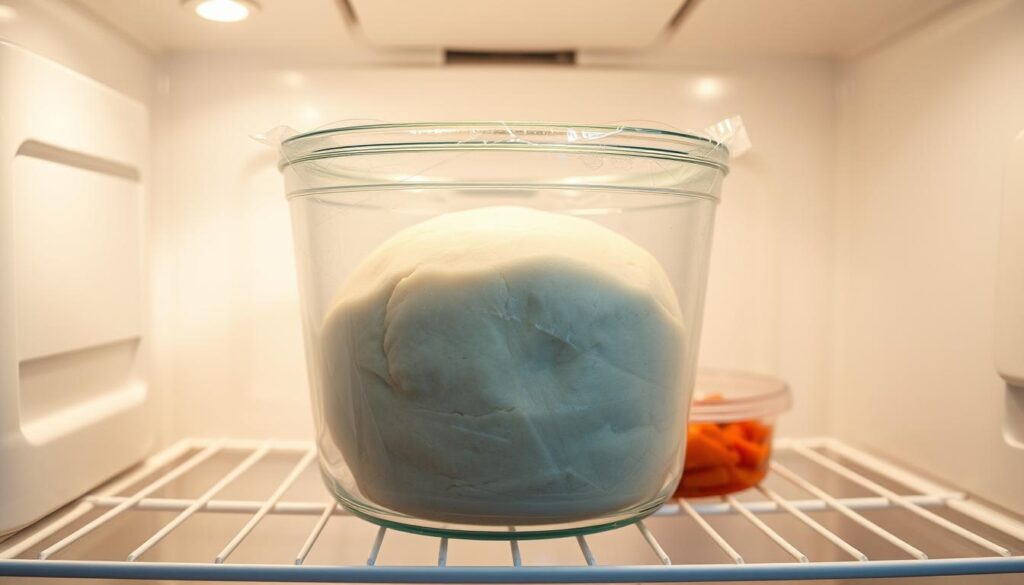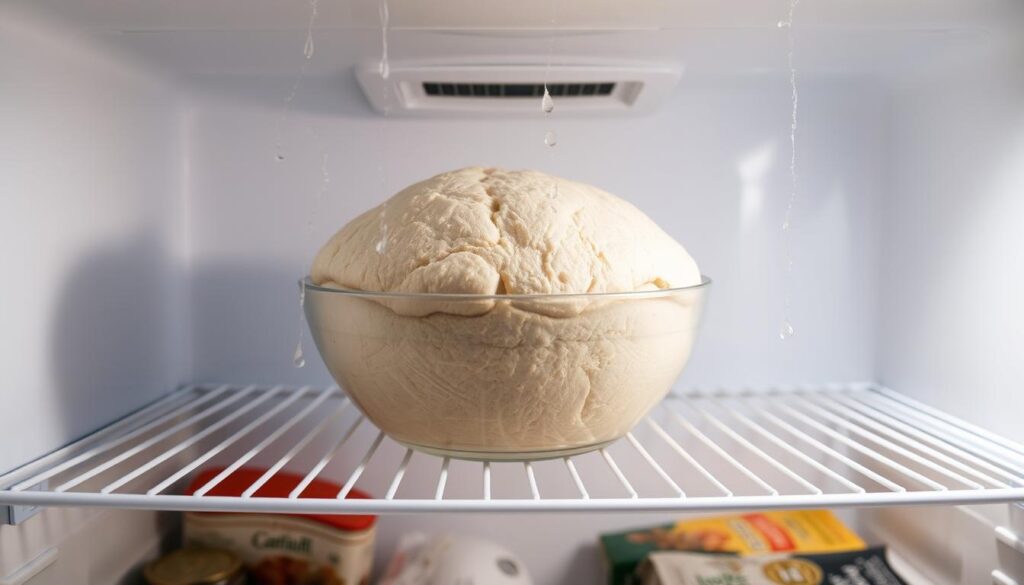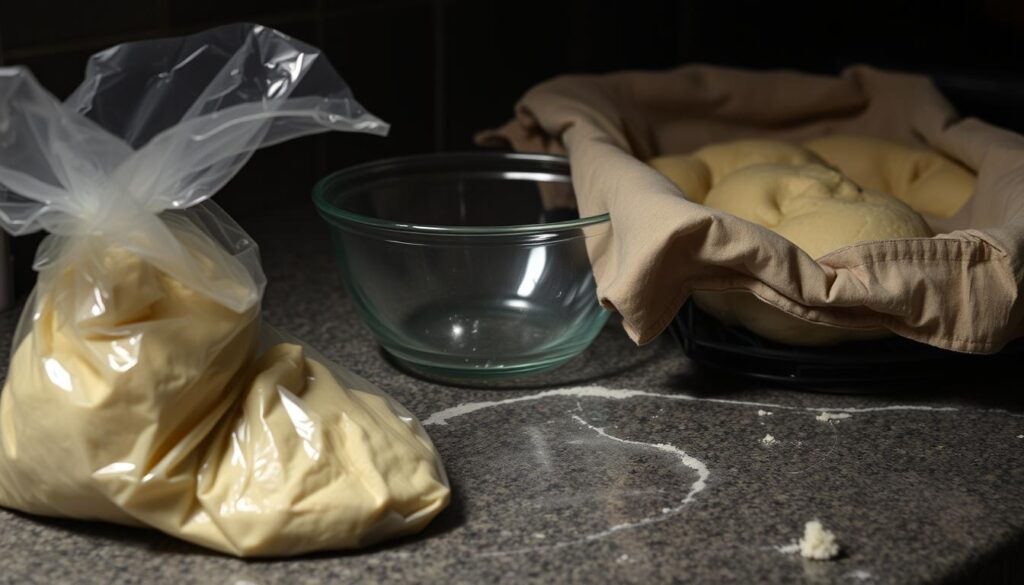Ever wondered how long your bread dough can wait in the fridge without losing its rise? The answer is key to whether your loaf is airy or dense, flavorful or flat. Storing bread dough in the fridge is more than just a convenience—it’s a science that affects your final bake.
From sourdough to enriched recipes, each type has its own limits. Without knowing the exact timeline, you might risk over-fermentation or lose flavor.

Key Takeaways
- Storage time varies: sourdough can last up to two weeks, while enriched dough needs 2-3 days.
- Cold slows yeast but doesn’t stop it entirely—timing matters for texture.
- Proper wrapping prevents drying without trapping too much moisture.
- Over-refrigeration kills yeast, ruining rise.
- Flavor improves with slow fermentation but only if stored correctly.
Understanding Bread Dough Refrigeration
Learning how to refrigerate bread dough opens up a world of convenience and flavor. It’s not just about keeping dough fresh longer. It’s a way to pause the dough’s development to fit your schedule. This pause also improves the dough’s texture and taste.
Why refrigerate bread dough? Here are the main reasons:
- Flexible baking: Store dough for days without losing quality.
- Flavor boost: Slow fermentation makes bread sweeter and smellier.
- Time-saving: Make dough ahead of time to avoid last-minute stress.
The science behind cold fermentation is all about temperature. Yeast works slower at 34–40°F (1–4°C). This slow pace lets gluten strengthen without overproofing. It also lets enzymes break down starches into sugars, making the crust richer and layers more complex.
Refrigerated dough offers more than just convenience. The cold storage process:
- Creates complex flavors through gradual acid production.
- Prevents dough from drying out by slowing moisture loss.
- Allows precise timing for optimal oven spring during baking.
Professional bakers use this method to balance quality and practicality. Whether you’re making sourdough or enriched loaves, knowing these principles ensures every batch meets your expectations.
How Long Can You Keep Bread Dough in the Fridge?
Managing dough refrigeration time depends on the dough type. Here’s how long you can safely refrigerate different bread doughs to maintain peak quality.
Standard Yeast Dough: 3-5 Days
Standard yeast dough should stay in the fridge 3–5 days. The yeast remains active but slows down. Beyond 5 days, the dough may over-ferment, leading to off flavors. Store it airtight to prevent drying.
Sourdough: 1-2 Weeks
Sourdough’s natural acidity lets you refrigerate it 1–2 weeks. Lactic acid slows fermentation, extending shelf life. Check for a tangy scent weekly to confirm freshness. No need to worry about overproofing for up to 14 days.
Enriched Dough: 2-3 Days
Enriched dough with butter, eggs, or milk lasts 2–3 days. Fats and sugars break down faster in cold temps. Use within this window to avoid rancid flavors or texture loss.
No-Knead Dough: Up to 2 Weeks
No-knead dough can stay refrigerated up to 2 weeks. Its simple recipe with minimal ingredients resists over-fermentation. The longer fridge time lets flavors develop without spoilage risks.
Factors Affecting Refrigeration Time
Storing bread dough in the fridge involves balancing several factors. Ingredients, equipment, and environment play a big role in keeping dough fresh. Here are the key things to consider:
- Temperature consistency is essential. Your fridge should be between 34°F and 38°F. Warmer temperatures speed up yeast activity, while colder temperatures slow it down.
- The type of flour used is important. Bread flour with high protein lasts longer than whole-grain flour. If the dough is over-proofed before chilling, it will not last as long.
- Ingredients like added sugars or fats, such as honey or butter, reduce the time dough can be stored. The more of these ingredients in your recipe, the sooner you’ll need to bake the dough.
- How you mix the dough affects its structure. Over-kneading can cause the dough to dry out faster. On the other hand, undermixing can lead to clumps during storage.
Humidity in your fridge also affects dough storage. Too much moisture can make the dough soggy, while too little can cause it to crack. Use containers that are airtight and have room for expansion. Check the expiration dates on yeast packets, as fresh yeast is essential for dough quality. Adjust recipes with ingredients like eggs or fruit, as they have shorter shelf lives. Sealing dough properly helps it last longer, but always check for any signs of spoilage like bad smells or color changes.
Proper Dough Preparation Before Refrigeration
Getting your dough ready right is key to storing bread dough well. Follow these tips for storing bread dough to get great results every time. Each step is important for yeast activity and the quality of your loaf.
Initial Fermentation Considerations
Timing is everything when it comes to refrigerating your dough:
- Chilling it right away slows down fermentation for later baking
- A 30-minute rest at room temperature strengthens the gluten structure
- After fermentation, refrigeration boosts complex flavors
Dough Temperature Before Storage
Keep the dough at 65–70°F before chilling. Sudden cold can slow down yeast. Here’s what to do:
- Cool the dough in a shaded area 30 minutes before refrigeration
- Don’t put warm dough straight into cold storage
Container Selection for Refrigeration
Choose containers that let dough expand while keeping it fresh:
- Glass jars with vented lids for airflow
- Food-grade plastic bins with 50% extra space
- Ceramic bowls covered with damp towels
Containers need room for dough to expand without trapping moisture. Properly prepared dough keeps its structure in the fridge. This ensures it will rise well when baked later.
Best Containers for Storing Bread Dough
Choosing the right container is key for bread dough storage success. It keeps your dough from drying out and lets it rise properly. Find out which containers are best for refrigerator storage for bread dough.
Glass vs. Plastic Containers
Material choice affects durability and performance:
- Glass: Non-reactive, safe for acidic doughs like sourdough. Use wide-mouth jars or bowls with loose-fitting lids for airflow.
- Plastic: Lightweight and affordable, but pick BPA-free options. Avoid thin plastics that warp in the fridge.
Using Bowls with Plastic Wrap
For a budget-friendly option:
- Lightly grease the bowl with oil to prevent sticking.
- Stretch plastic wrap over the dough, pressing it against the surface to seal in moisture.
- Secure with a rubber band and cover with a lid or towel for extra protection.
Professional Dough Storage Solutions
Bakers use special tools like vented proofing boxes or lidded dough tubs. Look for containers that are 2-3 times the dough’s volume for expansion. Reusable silicone stretch lids (like those from Kitchen Craft) fit over bowls, creating an airtight seal without plastic wrap.
Signs Your Refrigerated Dough Has Gone Bad

Knowing when to throw away refrigerated dough is key to keeping it safe. Look out for these warning signs:
- Visual cues: Grayish-brown patches or fuzzy mold spots in any color.
- Odor alerts: Pungent alcohol fumes, vinegar-like acidity, or rotten egg smells.
- Texture shifts: Dough that oozes liquid, stays indented, or feels too sticky or dry.
Healthy dough should feel slightly elastic and smell mildly fermented. If your dough has several of these problems, it’s best to throw it away. This prevents foodborne illnesses. Always check your dough before using it, even if it’s been stored correctly.
If you’re unsure, trust your senses. Bad dough can have harmful bacteria. So, it’s better to be safe than sorry. Storing dough properly and checking it regularly helps keep it fresh and safe to eat.
How to Properly Wrap and Store Dough in the Fridge
Learn the best ways to store bread dough. Proper wrapping and placement keep your dough fresh and ready to rise. Follow these steps for consistent results.
Preventing Dry Crust Formation
Keep dough surfaces moist to avoid drying. Use these methods:
- Coat the dough surface lightly with vegetable oil before covering.
- Seal dough tightly in airtight containers to retain humidity.
- Place a damp cloth between the dough and lid for certain dough types.
Managing Dough Expansion
Allow space for slow fermentation:
- Select containers 2–3 times larger than the dough’s original size.
- Avoid pressing dough into containers—let it expand freely.
- No need to punch down dough before refrigeration; let it rest after initial rise.
Organizing Your Refrigerator for Dough Storage
Optimize fridge space to protect dough quality:
- Store containers on middle shelves for stable, consistent temperatures.
- Avoid door shelves—temperature fluctuations here disrupt fermentation.
- Wrap dough tightly in plastic wrap or parchment paper to block odor absorption.
Regularly check container seals and position dough away from acidic or strong-smelling foods like onions or cheese.
Bringing Refrigerated Dough Back to Room Temperature
When you take bread dough out of the fridge, it needs to warm up before baking. This step is key for yeast activity and dough texture. Here’s how to do it right.

Proper Timing for Different Dough Types
Lean doughs like baguettes or sourdough need 1–2 hours. Enriched doughs (brioche, cinnamon rolls) take 2–3 hours because of their fat content. Check if the dough is soft and pliable. If it’s stiff, it’s not ready yet.
Techniques to Speed Up the Warming Process
- Use a proofing box (e.g., ChefSteps Proofer) at 75°F to speed up evenly.
- Place dough in a warm pantry, away from direct heat.
- Preheat an oven to 100°F, turn it off, and let dough sit inside for 30–60 minutes.
Signs Your Dough is Ready to Use
Check dough by gently pressing it. If it springs back slowly, it’s ready. The ideal temperature is 72–75°F. Don’t use dough colder than 65°F, as it won’t rise well. If it smells sour or acidic, discard it.
Warming dough slowly is important to keep its structure. Rushing can lead to uneven rise. Slow warming ensures the best texture. Adjust your methods based on the dough type and your kitchen.
Freezing vs. Refrigerating Bread Dough
Choosing between freezing and refrigerating impacts your bread’s texture and longevity. Bread dough storage methods differ in how they affect yeast activity and gluten structure. Refrigeration preserves freshness for days to weeks, while freezing extends viability to months.
| Factor | Refrigeration | Freezing |
|---|---|---|
| Storage Time | 3–14 days | 2–6 months |
| Texture Impact | Mild gluten relaxation | Potential ice crystal damage |
| Prep Steps | Cover loosely, no extra steps | Portion, wrap airtight, label dates |
| Best For | Sourdough, no-knead, or upcoming bakes | Large batches of lean dough (e.g., baguettes, ciabatta) |
- Freeze dough in individual portions for easy use
- Use parchment paper between layers to prevent sticking
- Thaw frozen dough at room temperature for 2–4 hours before baking
Refrigeration keeps yeast active but limits storage time. Freezing halts fermentation but requires careful preserving dough in the fridge alternatives for short-term needs. Opt for the method matching your baking schedule and desired texture.
Common Mistakes When Storing Bread Dough
Keeping prolonging bread dough freshness means avoiding common errors. Even with the best storage methods, mistakes can happen. Learn to spot and fix these issues to ensure your dough is always ready for baking.

Inadequate Covering Methods
Air and moisture harm dough. Using paper towels or cling wrap that tears easily lets air in, drying the dough. Always use airtight containers like Rubbermaid or Gladware or parchment-lined bowls with a lid. Double-seal with plastic wrap and a lid for extra protection.
Refrigerator Temperature Issues
Fluctuating temps hurt yeast activity. Avoid spots near fridge doors or vents where temps drop too low (below 34°F) or rise above 40°F. Use a thermometer to check zones. Place dough in the coldest, stable shelf at the back for consistent cooling.
Storing Dough for Too Long
Storing dough for too long causes over-fermentation. Sourdough past 2 weeks develops off-flavors. Mark containers with dates. Discard dough if it smells sour or has slimy texture. For over-fermented dough, knead in fresh yeast and a bit of flour to revive it.
How Refrigeration Affects Bread Flavor and Texture
Refrigerating bread dough changes its taste and feel. Yeast works slower, but enzymes keep breaking down starches. This makes the dough tangy, like in sourdough. The tanginess gets stronger with time, reaching its peak in 24–72 hours.
The dough’s texture also changes a lot. Longer cold storage makes the gluten stronger. This lets the dough puff up more, making it lighter and fluffier. The crust gets crisper too. But, if you refrigerate it too long, it can get too dry or sour.
- Flavor: Tanginess builds gradually—12 hours adds subtle depth; 48 hours enhances complexity.
- Texture: Optimal refrigeration time balances chewy crumb and crust crispness. Exceeding 7 days may cause dryness in whole-grain doughs.
- Flour type: Whole wheat and rye benefit most from extended cold storage, as their complex starches need longer breakdown. Refined flour doughs like baguettes reach peak texture in 18–24 hours.
Try different refrigeration times to find what you like. Shorter times (12–24 hours) give milder flavors. Longer times (48–72 hours) make the flavors more complex. Remember, sourdoughs do best with longer times, while enriched doughs like brioche are best at 18–24 hours. Adjust based on what you want to taste and feel.
Conclusion
Knowing how long you can keep bread dough in the fridge is key for great baking. Standard yeast dough lasts 3–5 days, sourdough up to two weeks, and enriched doughs 2–3 days. Using airtight containers and keeping the fridge at a steady temperature is important. This method slows down fermentation, making flavors better and saving time.
Always check the dough for mold or bad smells before baking. This way, you can plan ahead without losing flavor. Try different storage times to find your favorite taste. By following these steps, you get safe and tasty bread every time. Remember, throwing away old dough keeps your kitchen safe.
Learning how to refrigerate dough well makes baking easier and better. It opens up new possibilities for you to try different recipes and flavors. With practice, you’ll get better at making delicious bread every time.
FAQ
How long can you keep bread dough in the fridge?
The fridge time for bread dough varies. Standard yeast dough lasts 3-5 days. Sourdough can last 1-2 weeks. Enriched dough stays fresh for 2-3 days. No-knead dough can be stored for up to 2 weeks.
What is the best practice for storing bread dough?
Use airtight containers and keep the fridge at 34°F-38°F. Make sure there’s enough space for the dough to expand. Wrap the dough well to prevent drying and oxidation.
Can I refrigerate bread dough for longer than recommended?
It’s not wise to keep dough longer than suggested. Longer storage can cause over-fermentation. This can harm the dough’s flavor, texture, and quality.
What should I look for to determine if my refrigerated dough has gone bad?
Check for gray discoloration, mold, and bad smells. Also, look for a loose or sticky texture. These are signs of spoilage.
How does refrigerating dough affect its flavor and texture?
Refrigeration makes the dough’s flavor more complex. It develops organic acids during cold fermentation. This improves the texture, making the crumb more open and the crust crisper.
Should I punch down dough before refrigerating it?
It depends on the dough type. Punching down is good for doughs that rise a lot. But, for some recipes, let it ferment a bit before refrigerating to enhance flavors.
What type of container is best for storing bread dough?
Airtight containers are best. Choose glass or plastic that allows for expansion. Make sure it keeps moisture but doesn’t trap too much liquid.
Is it better to freeze or refrigerate bread dough?
It depends on your needs. Refrigeration is good for short-term storage. Freezing is better for longer storage. But, freezing can change the texture, so it’s a trade-off.
What common mistakes should I avoid when storing bread dough in the fridge?
Don’t use poor covering methods that let air in. Avoid storing in areas with changing fridge temperatures. And, don’t keep dough longer than recommended to avoid spoilage and quality loss.
